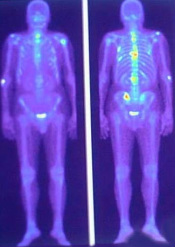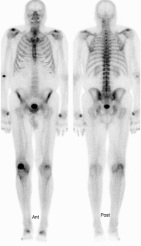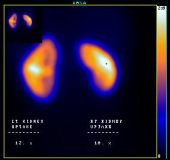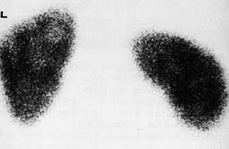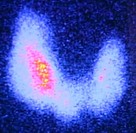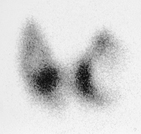Nuclear Medicine
Nuclear Medicine is when a tiny amount of a radioactive isotope called a tracer is injected into a patient. The tracer procudes radiation, so when a body part picks up the tracer, a scanner can capture an image of it. One of the most popular tracers used is called Technetium-99.
Common Types of Scans
Bone Scan
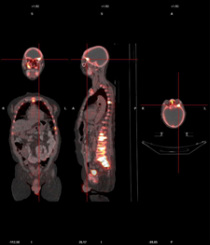
Using Enhanced Color
A bone scan is a scan that is used to look for bone growth or breakdown, spreading cancer, and abnormalitiies such as arthritis, fractures, or tumors. A bone scan can find problems days to months before a regular x-ray can.
If a dark spot or "cold" spot is found in an area, it means the tracer was not absorbed as much, meaning the lack of blood supply, meaning the presence of certain types of cancer. Light or "hot" spots mean the presence of rapid bone growth, that can mean arthritis, infections, fractures or tumors. A bone scan can be done on the whole body, or just a certain part. The most common area scanned is the lumbar area on the spine.
For more info about bone scans, Click Here
If a dark spot or "cold" spot is found in an area, it means the tracer was not absorbed as much, meaning the lack of blood supply, meaning the presence of certain types of cancer. Light or "hot" spots mean the presence of rapid bone growth, that can mean arthritis, infections, fractures or tumors. A bone scan can be done on the whole body, or just a certain part. The most common area scanned is the lumbar area on the spine.
For more info about bone scans, Click Here
Bone scan process
Bone scans are often confused with Bone density scans, which do not use radioisotopes when performing.
Renal Scan
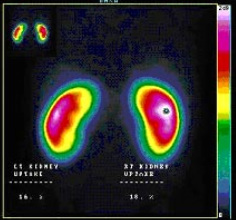
A renal scan is a scan of the kidneys in order to find abnormalities such as obstructions like kidney stones, while evaluating urine and blood flow within the kidney. Dark spots in the picture can mean blockage of vessles, fluid pockets, infection pockets, types of cancer, or scarring. Hot spots can indicate certain types of cancer.
There are two types of kidney scans; a cortical scan and a functional scan. In a cortical scan, the purpose is to evaluate the shape of the kidney. A functional scan measures the amount of time it takes for the tracer to move throughout the kidney, urin, and bladdar.
For more info about renal scans, Click Here
There are two types of kidney scans; a cortical scan and a functional scan. In a cortical scan, the purpose is to evaluate the shape of the kidney. A functional scan measures the amount of time it takes for the tracer to move throughout the kidney, urin, and bladdar.
For more info about renal scans, Click Here
Thyroid Scan
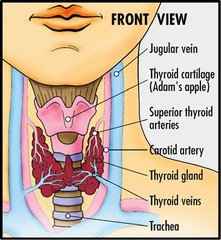
Using Iodine or Technetium-99 as a tracer, a thyroid scan is a scan of a patient's thyroid gland. This scan can tell how active a patient's thyroid gland is, along with its location, size, and shape. A thyroid scan's purpose is to see if a patient has hyperthyroidism (thyroid produces too much thyroid hormone), or if the thyroid cancer has spread out of the thyroid gland. The scan to see if the cancer has spread throughout the body is called a whole-body thyroid scan, and is only done on people that are being treated for thyroid cancer.
For more info on thyroid scans, Click Here
For more info on thyroid scans, Click Here
MUGA Scan
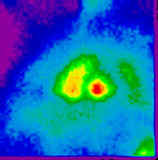
A MUGA scan is when the tracer Technetium-99 is attatched to red blood cells. These blood cells are injected into the blood stream. From this a MUGA scan can measure the amount of blood pushed out of the left ventricle with each heart beat. The MUGA scan is an alternative to the chemotheraputic drug Adriamycn that can be toxic to the heart.
MUGA stands for Multiple Gated Acquisition scan.
For more info, Click Here!
MUGA stands for Multiple Gated Acquisition scan.
For more info, Click Here!
Nuclear Gamma Camera
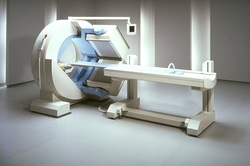
A gamma camera is the machine that picks up gamma rays from the tracers injected into a patient in order to assess a patient's body part. Your whole body can be scanned by a gamma camera, and radioisotopes are very safe.
There are many Gamma Camera models, but most of them do about the same thing- capture images of gamma ray emissions by detecting single photons (the energy emitted by radioisotope).
There are many Gamma Camera models, but most of them do about the same thing- capture images of gamma ray emissions by detecting single photons (the energy emitted by radioisotope).
Thanks for checking out Nuclear Medicine!
For more information about anything Nuclear, Click Here!
Home
For more information about anything Nuclear, Click Here!
Home
